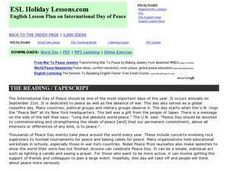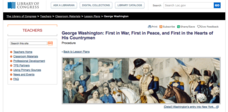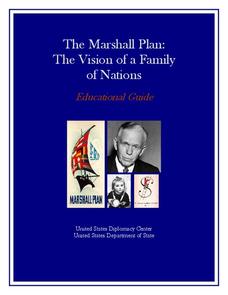Spark Notes
War and Peace by Leo Tolstoy: Study Guide - Mini Essays
In this online interactive literature instructional activity, students respond to 8 short answer and essay questions about Leo Tolstoy's War and Peace. Students may check some of their answers online.
Curated OER
Vietnam 1945 - 1975 :The 10,000 Day War
Each phase of the Vietnam War is fully developed and defined in terms of political cause and effect and social action. Phase one covers the onset of the war in 1945 through the French defeat at Dienbienphu. Phase two discusses American...
DocsTeach
Cultural Diplomacy and Propaganda During the Cold War
There's a fine line between diplomacy and propaganda. Young historians consider that boundary by examining documents from the Cold War, including memorandum about the lunar program and Peace Corps in addition to a propaganda film. Using...
Curated OER
Let There Be Peace: Nobel Prize Winners
What is the Nobel Peace Prize? After they establish criteria for great leadership, secondary learners read a New York Times article about President Jimmy Carter's acceptance of the Nobel Peace Prize in 2002. Individuals research the...
US Institute of Peace
Perspectives on Peace
Is peace simply the absence of war, or is there more to the story? Young social scientists define peace in the second installment of a 15-part series. Groups work together to explore cultural concepts of peace and the peacemaking process...
Center for History Education
Breaking the Great League of Peace and Power: The Six Iroquois Nations During and After the American Revolution
What happens when you can't remain neutral? An informative lesson explores the impact of the American Revolution on the Iroquois Nations. Scholars learn about the six Iroquois nations and their treaty with the newly formed American...
Curated OER
Paris Peace Conference: Writing a Treaty to End World War I
How did World War I end? Tenth graders role play as experts from countries that were involved in World War I. They write a treaty to end the war and compare it to the Treaty of Versailles.
National Park Service
A Natural Resource Called Peace
Get your pupils outside and teach them about peace at the same time! Scholars create a list describing peace, hike outside, add to that list, and later create poems. The exercises support differentiation for your individual classes as...
United Nations
The UN: Working for Us All
The United Nation's role in world diplomacy is critical, but its enforcement is limited. Using activities such as role plays and simulations, classmates consider the role the UN plays in world peace keeping. The unit plan includes five...
Curated OER
The Cold War: Chapter 9: Lesson 1
Used as a quick review of the Cold War, Korean War, and Cuban Missile Crisis, this presentation could be in many scenarios. However, the graphics and question types seem more appropriate for younger students, while the content is geared...
National Endowment for the Humanities
Ending the War, 1783
The various peace proposals, made by both sides, to end the Revolutionary War come under scrutiny in this final activity of a three-part series on the war. Class members read primary source documents and compare them with military...
Curated OER
International Day of Peace
To recognize the International Day of Peace, pupils complete activities such as reading a passage, phrase matching, fill-in-the-blanks, correct words, multiple choice, spelling sequencing, scrambled sentences, asking questions, take a...
Curated OER
Questions of War and Peace: Using Case Studies to Teach the History of American Foreign Policy
Students read three case studies to focus on how the United States dealt with foreign policy issues. In groups, they read about the decision to drop the atomic bomb, the commitment of troops to Vietnam and wwhether to send troops to...
DocsTeach
Cultural Diplomacy and the Smith-Mundt Act
During the Cold War, the United States used everything from bookmobiles to radio stations to improve its image globally. Using documents from the programs, including photographs and official memos, individuals consider how the United...
Curated OER
Facing the Ghosts of Our Past
A reading of a New York Times review of the movie Beloved launches research into how the Civil War affected the lives of people living during this period. Creative thinkers select a person from an included list of historical figures and...
Curated OER
Peace
Ninth graders explore through research changes in Japan following A-bomb, discuss how people of all ages can model tolerance and peaceful coexistence, examine Constitution of Japan, and identify its three basic tenants.
Curated OER
The Wounds of War
Learners examine how the lives of civilians who experience war are changed forever. They read and discuss first-hand accounts of citizens in Sarajevo, and consider the many needs of people, and how wars affect people's ability to meet...
Curated OER
Should US Officials & Health Professionals be Investigated for War Crimes?
Students explore ethical issues. In this human rights lesson, students read articles and documents related to torture used in government investigations and if medical ethical guidelines were adhered to. Students respond to discussion...
Curated OER
The Aftermath of War
Students share their opinions on the war in Iraq. After reading an article, they identify the thoughts of President Bush on the conflict. In groups, they share their opinions for and against current United States policy in Iraq and the...
DocsTeach
Analyzing Woodrow Wilson's Fourteen Points
The end of a war means the causes were resolved, right? Not for World War I. By examining Woodrow Wilson's Fourteen Points, budding historians consider imperialism, nationalism, militarism, and alliances, as well as Wilson's efforts to...
Curated OER
Europe in Upheaval (1850 - 1914)
Europe was in a state of transition and upheaval that spanned a time of 60 years, beginning in 1850 and running through the first World War. Uncover the wars, key players, politics, and social movements that marked this time period in...
Library of Congress
George Washington: First in War, First in Peace, and First in the Hearts of His Countrymen
Does the lens of history portray George Washington as a good leader? A three-lesson unit looks at Washington's early military career as the commander of the Virginia Regiment, his role in the fight for independence...
Maryland Department of Education
The Concept of Identity Lesson 8: Propaganda in Visual Media
Visual and print propaganda are featured in a lesson that asks readers of A Separate Peace to examine the techniques used in propaganda from World War I, World War II, presidential elections, and in the novel.
US Department of State
The Marshall Plan: The Vision of a Family of Nations
The European Recovery Act (aka the Marshall Plan) was designed to bring together and develop a spirit of cooperation among European nations after World War II. Class members examine the materials from the Marshall Plan exhibit and assess...

























